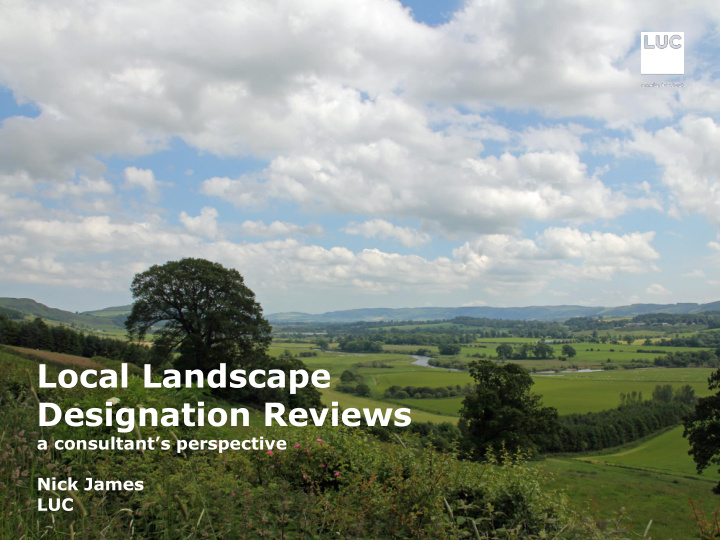



Local Landscape Designation Reviews a consultant’s perspective Nick James LUC
LUC and local landscape designation reviews Track record in LCA Involvement in LLDR – in Scotland and elsewhere Early implementation of SNH/HS guidance Why do we want local landscape designations? • How much should we designate? • Who should we involve, how and when? • Distinguishing between landscape character and landscape quality • Cross boundary consistency • Remembering the undesignated •
Why do we want local landscape designations? A range of approaches: Celebrating the landscape resource • Managing change in our best and most valued landscapes • Representing the landscapes that are typical of an area • Conserving the setting of villages, towns and cities • Supporting tourism and recreation and associated economic activity •
Evaluation criteria Typicality Typicality: • Does the landscape contain features or a • Rarity • combination of features that recur Condition or quality • throughout the Scottish Borders and Scenic qualities • therefore contribute to its wider identity, image and sense of place locally, regionally Enjoyment • or nationally? Cultural qualities • Naturalness • Categories: Setting • High – The landscape contains features or • combination of features that frequently recur Views • throughout the Scottish Borders Connectivity • Medium – The landscape contains features • or combination of features that occasionally recur throughout the Scottish Borders Strategies, plans and projects • Low – the landscape does not contain • Tourist economy • features which recur throughout the Scottish Scale and identity • Borders
The technical assessment Draft evaluation results: Settlement setting •
The technical assessment Draft evaluation results: Wildness •
The technical assessment Draft evaluation results: Rarity •
How much should we designate? Different starting points: Fife Council – previous AGLV coverage too extensive and policy • weakened Scottish Borders Council – previous AGLV focus on uplands – lack of • recognition of other important landscapes Perth and Kinross – partial / inconsistent coverage • Methodology helps rank landscapes from the lowest to the highest quality Need to decide a ‘cut off’ in terms of what qualifies for designation – for each council area Stakeholders can help confirm which are locally significant places Policy inputs can help guide the total extent of locally designated landscapes
Who should we involve, how and when? Widely recognised that some level of public involvement is essential to inform the process engagement wrapped into statutory consultation on local development • plans stakeholder workshops – local representatives • public survey – favourite places • review panels • Working with information from public engagement – informing and testing, not driving the results Awareness of local issues is an important factor
Distinguishing between landscape character and landscape quality Detailed but sometimes vexed methodological issue First part of the review process based on evaluation of landscape character areas This helps identify ‘areas of search’ but need to recognise that: Quality can vary within a given character area (so may want to focus on • part of a character area) Important landscapes can include different areas with differing • character (so may want to focus on adjoining parts of different character areas) Need a clearly justified, qualitative process for second part of the review process – field survey, professional judgement
Cross boundary consistency SNH/HES guidance significant step forward in promoting a consistent approach across Scotland But it is about identifying landscapes that are important within the context of the council area in question – decisions about purpose and extent part of that process Very unlikely therefore that there will be consistency in pattern of designation between different council areas Does that matter? Boundary issues? Managing the national landscape resource? Public and developer confidence?
Remembering the undesignated Designating and protecting locally important landscapes only part of the picture Risk that there will be a growing gap between the designated and the undesignated An all landscapes approach means it’s important to manage undesignated landscapes too First part of the LLDR process provides valuable information about all an authority’s landscapes – the good, the bad and the ugly Should balance conservation of the best landscapes with measures to – restore and enhance wider landscapes
Thank you
Recommend
More recommend